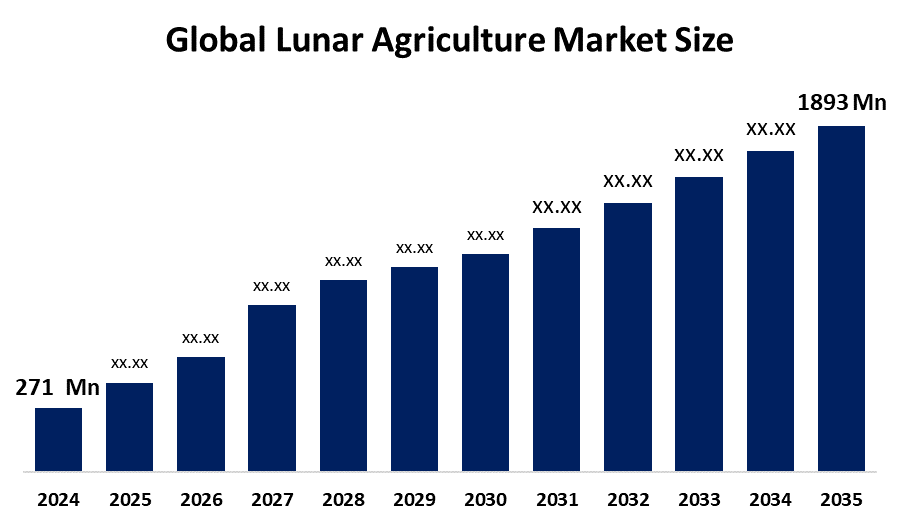
Top 15 Lunar Agriculture Companies in the Globe 2025: Statistical View by Spherical Insights & Consulting
RELEASE DATE: Aug 2025 Author: Spherical InsightsRequest Free Sample Speak to Analyst
Description
According to a research report published by Spherical Insights & Consulting, The Global Lunar Agriculture Market Size is projected to Grow from USD 271 Million in 2024 to USD 1893 Million by 2035, at a CAGR of 19.33% during the forecast period 2025–2035. The Global Lunar Agriculture Market is expanding due to the rise in space exploration, the need for sustainable food production on the Moon, improvements in hydroponics and controlled environment agriculture, and government programs that promote extraterrestrial colonization and research.
Introduction
The Global Lunar Agriculture Market operates to develop sustainable agricultural solutions for Moon-based food production, which supports extended space missions and extraterrestrial colonization. The market expansion is driven by expanding space exploration operations as well as rising interest in automated life support systems for lunar bases and advancements in hydroponics, aeroponics, and vertical farming techniques. Modern technology enables effective resource utilization of water recycling systems, artificial lighting, and soil-less cultivation methods to overcome lunar environmental challenges of low gravity and extreme temperatures. Space programs and international partnerships between governments and space agencies, including NASA, ESA, and CNSA, provide funding for lunar agricultural research development. The programs work toward two main objectives, which include reducing Earth-based supply dependence and enhancing mission sustainability while supporting the establishment of human settlements in space. The growing involvement of private space companies alongside rising commercial space exploration interest drives market development, which underlines the essential role of lunar agriculture for space colonization and scientific development.
Navigate Future Markets with Confidence: Insights from Spherical Insights LLP
The insights presented in this blog are derived from comprehensive market research conducted by Spherical Insights LLP, a trusted advisory partner to leading global enterprises. Backed by in-depth data analysis, expert forecasting, and industry-specific intelligence, our reports empower decision-makers to identify strategic growth opportunities in fast-evolving sectors. Clients seeking detailed market segmentation, competitive landscapes, regional outlooks, and future investment trends will find immense value in the full report. By leveraging our research, businesses can make informed decisions, gain a competitive edge, and stay ahead in the transition toward sustainable and profitable solutions.
Unlock exclusive market insights-Download the Brochure now and dive deeper into the future of the Lunar Agriculture Market.
Lunar Agriculture Market Size & Statistics
The Market Size for Lunar Agriculture Was Estimated to be worth USD 271 Million in 2024.
The Market Size is Going to Expand at a CAGR of 19.33% between 2025 and 2035.
The Global Lunar Agriculture Market Size is anticipated to reach USD 1893 Million by 2035.
North America is expected to generate the largest demand during the forecast period in the Lunar Agriculture Market.
Europe is expected to grow the fastest during the forecast period in the Lunar Agriculture Market.

Regional growth and demand
Europe is expected to grow the fastest during the forecast period in the lunar agriculture market. The region's growth stems from the increasing investments in space research and sustainable innovations. The European Space Agency, together with its member countries and private entities, focuses on developing technologies for lunar exploration and off-Earth food production. Europe's strategy depends heavily on the advancement of hydroponics along with bioregenerative life support systems and greenhouse modules. Europe's development of scalable and effective lunar agriculture systems for future missions receives strong support from comprehensive regulations and academic research, together with worldwide cooperation.
North America is expected to generate the highest demand during the forecast period in the lunar agriculture market. The region's growth is due to its strong space exploration activities and modern agricultural research. Government support from NASA's Artemis program provides the region with substantial benefits, which focus on developing sustainable lunar exploration and Moon settlement. Private aerospace companies, including SpaceX, Blue Origin, and Sierra Space, collaborate with government agencies to accelerate research of farming operations outside of our planet. The leadership position of North America in developing suitable food production methods for lunar habitats stems from its investments in controlled environment agricultural technology.
Top 10 trends in the Lunar Agriculture Market
- Advancement in Controlled Environment Agriculture (CEA)
- Use of Hydroponics and Aeroponics Systems
- Development of Bioregenerative Life Support Systems
- Integration of AI and Robotics in Space Farming
- Lunar Soil (Regolith) Research for Plant Growth
- Government and Space Agency Collaborations
- Private Sector Investment in Space Farming
- Focus on Sustainable and Closed-Loop Systems
- Modular and Inflatable Lunar Greenhouse Designs
- Cross-Agency International Research Programs
1. Advancement in Controlled Environment Agriculture (CEA)
The precise control provided by CEA technologies allows for accurate management of temperature and humidity, along with light and nutrient levels, which makes them perfectly suitable for lunar environmental conditions. These systems ensure optimal plant development regardless of outside weather conditions, which enables sustainable food cultivation during long space explorations.
2. Use of Hydroponics and Aeroponics Systems
The root systems of plants in hydroponics and aeroponics receive their nutrients from either water or mist instead of soil. The Moon represents an ideal environment for soil-less methods because they use minimal resources to achieve maximum crop yields and spatial efficiency.
3. Development of Bioregenerative Life Support Systems
Plants function as essential elements in bioregenerative systems, which operate within closed-loop habitats that recycle air, water, and waste materials. The plants enable sustainable operations of long-term lunar missions through their oxygen production and food supply, which minimizes Earth-based resupply requirements.
4. Integration of AI and Robotics in Space Farming
Artificial intelligence, together with robotics, enables autonomous monitoring and maintenance of crops in lunar habitats. The technologies reduce human work requirements while detecting problems promptly and optimizing resource usage to ensure successful farming operations in distant, hostile lunar territories.
5. Lunar Soil (Regolith) Research for Plant Growth
Scientists research to discover effective approaches for enhancing lunar regolith through nutrient and microbial application to support plant growth. The knowledge of local resource crop cultivation methods allows for to reduction of Earth soil transport requirements while boosting sustainability.
Empower your strategic planning:
Stay informed with the latest industry insights and market trends to identify new opportunities and drive growth in the lunar agriculture market. To explore more in-depth trends, insights, and forecasts, please refer to our detailed report.
Top 15 Companies Leading the Lunar Agriculture Market
- NASA (National Aeronautics and Space Administration)
- European Space Agency (ESA)
- SpaceX
- Blue Origin
- Sierra Space
- Boeing
- Lockheed Martin
- Honeywell Aerospace
- Crop One Holdings
- AeroFarms
- Plenty Unlimited Inc.
- Orbital Farm
- Lunar Outpost
- Moon Express
- Redwire Space
1. NASA (National Aeronautics and Space Administration)
Headquarters: Washington, D.C., USA
NASA leads the investigation of lunar agriculture through its Artemis program, which works to establish self-sustaining food production systems on the Moon. Their research targets the creation of life support systems that regenerate biological resources, together with controlled environment agricultural techniques and methods to extract resources from lunar soil. NASA partners with universities and private enterprises to establish innovative space farming technology through which researchers aim to enable extended lunar missions and human colonization.
2. European Space Agency (ESA)
Headquarters: Paris, France
The European Space Agency (ESA) plays an essential role in advancing lunar agricultural practices because it focuses on creating sustainable habitats for off-Earth environments. The agency provides financial support to study hydroponics systems together with nutrient recycling and artificial lighting solutions, which function within lunar environments. The European Space Agency collaborates with its member countries and private organizations to develop technologies that enhance food production through closed-loop systems that support sustainability and increase Europe's participation in lunar exploration missions.
3. SpaceX
Headquarters: Hawthorne, California, USA
SpaceX services lunar agricultural operations by providing cost-effective launch systems that allow repeated deliveries of agricultural equipment and experimental supplies to the Moon. The Starship vehicle from SpaceX allows regular missions to the Moon, which supports the distribution of controlled environment agriculture technology. SpaceX aims to establish self-sustaining food production systems during Martian and lunar colonization efforts, which drives the development of lunar agricultural technologies for future Earth settlements.
4. Blue Origin
Headquarters: Kent, Washington, USA
Blue Origin dedicates its efforts toward establishing sustainable lunar exploration infrastructure by deploying agricultural technology to the Moon. The Blue Origin lander from Blue Origin aims to deliver equipment that supports the cultivation of plants inside lunar settlements. Blue Origin aims to establish permanent human habitation on the Moon through the combination of controlled environment farming with in-situ resource utilization, which will enhance self-reliance and advance agricultural technologies for extraterrestrial environments.
5. Sierra Space
Headquarters: Louisville, Colorado, USA
Sierra Space develops modular space habitats together with life support systems that integrate advanced agricultural solutions for lunar missions. The Dream Chaser spacecraft from Sierra Space serves as a transportation system that allows cargo, including agricultural experiments, to reach lunar outposts and space stations. The company Sierra Space leads the development of closed-loop ecosystems together with controlled environment agriculture, which are essential for sustaining human life on the Moon through extended missions and match the growing requirement for reliable off-Earth food production technologies.
Are you ready to discover more about the lunar agriculture market?
The report provides an in-depth analysis of the leading companies operating in the global lunar agriculture market. It includes a comparative assessment based on their product portfolios, business overviews, geographical footprint, strategic initiatives, market segment share, and SWOT analysis. Each company is profiled using a standardized format that includes:
Company Profiles
- NASA (National Aeronautics and Space Administration)
- Business Overview
- Company Snapshot
- Products Overview
- Company Market Share Analysis
- Company Coverage Portfolio
- Financial Analysis
- Recent Developments
- Merger and Acquisitions
- SWOT Analysis
- European Space Agency (ESA)
- SpaceX
- Blue Origin
- Sierra Space
- Boeing
- Lockheed Martin
- Honeywell Aerospace
- Crop One Holdings
- Others
Conclusion
The Lunar Agriculture Market will experience substantial expansion because of advancements in controlled environment agriculture, together with hydroponics and bioregenerative life support systems. The rising investments from space organizations and private corporations, together with government programs, are driving accelerated development of sustainable farming approaches for lunar settlements. The development of these innovative solutions plays a crucial role in establishing permanent human settlement on the Moon and supporting exploration missions and building independent food systems for extraterrestrial environments.
About the Spherical Insights & Consulting
Spherical Insights & Consulting is a market research and consulting firm which provides actionable market research study, quantitative forecasting and trends analysis provides forward-looking insight especially designed for decision makers and aids ROI.
Which is catering to different industry such as financial sectors, industrial sectors, government organizations, universities, non-profits and corporations. The company's mission is to work with businesses to achieve business objectives and maintain strategic improvements.
CONTACT US:
For More Information on Your Target Market, Please Contact Us Below:
Phone: +1 303 800 4326 (the U.S.)
Phone: +91 90289 24100 (APAC)
Email: inquiry@sphericalinsights.com, sales@sphericalinsights.com
Contact Us: https://www.sphericalinsights.com/contact-us
Need help to buy this report?